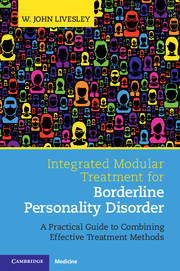 Integrated Modular Treatment for Borderline Personality Disorder
Integrated Modular Treatment for Borderline Personality Disorder Book contents
- Frontmatter
- Dedication
- Contents
- Preface
- Section 1 Introduction and Framework for Understanding Borderline Personality Disorder
- Section 2 Assessment and Treatment Planning
- Section 3 General Treatment Modules
- Section 4 Safety, Containment, and Engagement: The Initial Phase of Treatment
- Section 5 Improving Emotional Regulation and Modulation
- Introduction
- 15 General Principles for Improving Emotional Stability
- 16 Building Emotional Stability: Patient Education Awareness, and Emotion-Regulation Modules
- 17 Improving Emotional Processing
- Section 6 Exploration and Change: Treating Interpersonal Problems
- Section 7 Constructing an Adaptive Sense of Self
- Section 8 Retrospect and Prospect
- References
- Index
15 - General Principles for Improving Emotional Stability
from Section 5 - Improving Emotional Regulation and Modulation
Published online by Cambridge University Press: 16 February 2017
- Frontmatter
- Dedication
- Contents
- Preface
- Section 1 Introduction and Framework for Understanding Borderline Personality Disorder
- Section 2 Assessment and Treatment Planning
- Section 3 General Treatment Modules
- Section 4 Safety, Containment, and Engagement: The Initial Phase of Treatment
- Section 5 Improving Emotional Regulation and Modulation
- Introduction
- 15 General Principles for Improving Emotional Stability
- 16 Building Emotional Stability: Patient Education Awareness, and Emotion-Regulation Modules
- 17 Improving Emotional Processing
- Section 6 Exploration and Change: Treating Interpersonal Problems
- Section 7 Constructing an Adaptive Sense of Self
- Section 8 Retrospect and Prospect
- References
- Index
Summary
Unstable emotions dominate patients’ thoughts, behaviour, and experience. A more regulated and nuanced expression of emotion is necessary to provide the stability needed to treat other aspects of borderline personality disorder (BPD) and provide long-term stability. Thus success in increasing emotional regulation is a crucial change that governs overall rate of progress and determines ultimate outcome.
Emotion regulation is the ability to control the occurrence, intensity, experience, and expression of emotions. This requires skills in monitoring, appraising, and modulating emotional responses. This phase of treatment seeks to develop these abilities. However, in order to divide this broad goal into specific therapeutic tasks and identify suitable interventions, we need to understand the purpose of emotions, their role in adaptive behaviour, and how emotions are regulated.
What Do Emotions Do?
Emotions are crucial to organizing our experience of reality, regulating behaviour, guiding social interaction, and constructing an understanding of ourselves. Emotions are a rich source of information: they give meaning to experience by telling us what is important and what is not, what should be feared and avoided, and what is desirable and should be sought. Without them, the world would appear bland and nothing would stand out. The informational function of emotion was illustrated by the earlier discussion of anxiousness (Chapter 3) where it was noted that the anxiety aroused by the threat system tells us that something is wrong that needs our attention. With BPD, the constant heightened state of emotional arousal means that much of the informational value of emotions is lost. Since the same intense and diffuse emotions are aroused in many situations, they provide little useful information other than to indicate that something is wrong.
Emotions also direct our behaviour and help us to deal with situations: they tell us what to do, set priorities, and organize our actions. Worry or stress, for example, influence our thoughts and actions in various ways. We ponder on the problem, seek comfort from a loved one, turn to a friend for advice, or even withdraw within ourselves.
- Type
- Chapter
- Information
- Integrated Modular Treatment for Borderline Personality DisorderA Practical Guide to Combining Effective Treatment Methods, pp. 163 - 168Publisher: Cambridge University PressPrint publication year: 2017


